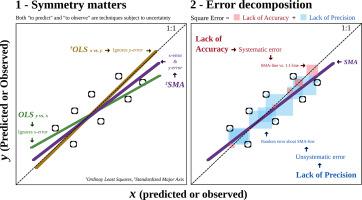Agricultural Systems ( IF 6.1 ) Pub Date : 2021-06-08 , DOI: 10.1016/j.agsy.2021.103194 Adrian A. Correndo , Trevor J. Hefley , Dean P. Holzworth , Ignacio A. Ciampitti

|
CONTEXT
In agricultural research and related disciplines, using a scatter plot and a regression line to visually and quantitatively assess agreement between model predictions and observed values is an extensively adopted approach, even more within the simulation modeling community. However, linear model fit, use, and interpretation are still controversial in the literature.
OBJECTIVE
The overall goal of this research is to evaluate the usefulness of a symmetric regression line to test agreement on predicted-observed datasets. The specific aims of this study are to: i) discuss the selection of a regression model to fit a line to the predicted-observed scatter, and ii) provide a geometric interpretation of the regression line, decomposing the prediction error into lack of accuracy and lack of precision components, via utilization of illustrative field crop datasets.
METHODS
This study tested and contrasted three alternative linear regression models (Ordinary Least Squares -OLS-, Major Axis -MA-, and Standardized Major Axis -SMA-) in terms of assumptions, loss functions, parameters estimates, and model interpretation for the predicted-observed case.
RESULTS AND CONCLUSIONS
When the uncertainty of predictions and observations are unknown, the SMA represents the most appropriate approach to fit a symmetric-line describing the bivariate predicted-observed scatter. The SMA-line serves as a reference to estimate a weighed difference between predictions and observations. Moreover, this symmetric regression can assist in the decomposition of the square error into additive components related to both lack of accuracy and precision. In summary, the SMA regression tackles the axis orientation problem of the traditional OLS (y vs. x or x or y) and allows to identify error sources that are meaningful to the user.
SIGNIFICANCE
This work offers a novel and simple perspective about the use of linear regression to assess simulation models performance. In order to assist potential users, we also provide a tutorial to compute the proposed assessment of agreement using R-software.
中文翻译:

重新审视线性回归以测试连续预测观察数据集的一致性
语境
在农业研究和相关学科中,使用散点图和回归线来直观地和定量地评估模型预测与观测值之间的一致性是一种广泛采用的方法,在模拟建模社区中更是如此。然而,线性模型拟合、使用和解释在文献中仍然存在争议。
客观的
本研究的总体目标是评估对称回归线在测试预测观察数据集一致性的有效性。本研究的具体目的是:i)讨论回归模型的选择,以拟合预测观察到的散点线,以及 ii)提供回归线的几何解释,将预测误差分解为缺乏准确性和通过利用说明性的大田作物数据集,缺乏精确的组件。
方法
本研究在假设、损失函数、参数估计和预测模型解释方面测试并对比了三种替代线性回归模型(普通最小二乘法 -OLS-、长轴 -MA- 和标准化长轴 -SMA-)观察到的情况。
结果和结论
当预测和观察的不确定性未知时,SMA 代表最合适的方法来拟合描述双变量预测观察散射的对称线。SMA 线用作估计预测和观察之间加权差异的参考。此外,这种对称回归可以帮助将平方误差分解为与缺乏准确度和精确度相关的附加分量。总之,SMA 回归解决了传统 OLS(y与x或x或y)的轴方向问题,并允许识别对用户有意义的错误源。
意义
这项工作为使用线性回归评估模拟模型性能提供了一个新颖而简单的视角。为了帮助潜在用户,我们还提供了使用 R 软件计算建议的协议评估的教程。











































 京公网安备 11010802027423号
京公网安备 11010802027423号